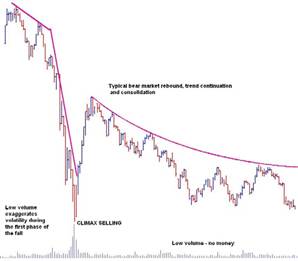Daryl Guppy wrote:
> Are we there yet? This is the key question and it relates to
> finding the bottom of the market.
> In many ways it's a pointless question. Even if we could identify
> the turning point in the market with a high level of certainty,
> there are very few people with the courage to enter at these low
> points.
> The more important thing to look for are the features that will
> help to identify, first, the end of the market fall and second,
> the development of a market recovery. These two events may be
> separated by a few months, or by many months.
> There are two important features that identify climax selling.
> The first is the rapid acceleration in the speed of the market
> fall. Like a Stuka dive-bomber, the market first rolls over slowly
> and then plunges in a vertical dive. This is fear at work.
> The second feature is a massive increase in volume. This is
> panic. Ordinary people are desperate to get out of the market.
> Generally the funds and institutions got out of the long-side of
> the market many months ago. The selling in January and February
> was dominated by institutions and funds. The current panic selling
> is thousands of small orders from retail investors desperate to
> get out of the market.
> During the bear market collapse, volumes decline. Fewer people
> want to buy stock so volatility increases because small trades
> have a disproportionate impact in a shallow market.
> This selling climax shakes out all the weak hands in the market.
> It kills the margin speculators. It wipes out those who have
> finally lost patience. It removes the speculative money in the
> market because people think the risk is too great. This is also
> called capitulation. Everybody gives up – and it influences the
> thinking of a generation. My parents, who lived through the
> depression, could never entirely shake the idea that the market
> was a dangerous place.

> The activity in the Dow Jones Industrial Average and other global
> markets shows an acceleration of downwards momentum. The massive
> increase in volume has not yet developed and this suggests the
> market bottom is not yet established. There is a high probability
> that markets will see a selling climax in the next 3 to 5 days.
> But here is the important difference. The recovery rally after
> climax selling is temporary. It is part of a longer-term
> consolidation pattern that may last months, or even a year, and
> make more new lows before a new sustainable uptrend can develop.
> The potential shape of the recovery is shown in the chart. The
> bull market rebound rally follows a temporary selloff. A bear
> market rebound rally follows climax selling. It is a relief
> really, but it is not part of a sustainable trend change.
> After a bear market, volumes remain low. When you lose trillions
> of dollars it takes a long time for spare change to start rattling
> around the economy again. Spare change drives the bull market
> because money is available for speculation.
> In the immediate bear market recovery period the market is
> dominated by professionals. Finance industry professionals are
> already being laid off. The least effective are the first to be
> let go. Only the best will survive the employment washout in the
> industry and these will be the ones defining the behavior of the
> consolidation and recovery market.
>
http://remnant888.blogspot.com/2008/11/ ... -tell.html
